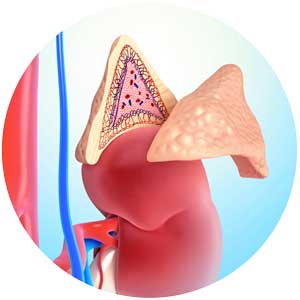FIRST-IN-CLASS PIPELINE
OR-449: An Oncology Drug with Potential for Multiple Clinical Approvals
Adrenocortical carcinoma (ACC) is a formidable disease, affecting approximately 1,500 individuals across the U.S. and Europe. Current therapies, including an FDA-approved treatment from more than 50 years ago, are at best modestly effective.
OR-449 targets the orphan nuclear receptor steroidogenic factor-1 (SF-1 or NR5A1), a tissue-selective transcription factor crucial for adrenal gland development. Orphagen has identified preclinical tumor models where OR-449 and other SF-1 antagonists inhibit tumor DNA synthesis. These findings support development of OR-449 for treatment of ACC and other cancers where SF-1 is highly elevated.
Unlike previous approaches such as cytotoxic chemotherapy, tyrosine kinase inhibitors, and immunotherapy, which lack adrenal tumor selectivity, OR-449 has both a unique mechanism of action for regulation of tumor growth and selectivity for a narrow set of tissues, including the adrenal gland. Pharmacological studies affirm OR-449’s potency and selectivity for SF-1, underscoring its potential for safety and efficacy.

More about ACC: ACC is an aggressive cancer of the adrenal gland. Surgical removal of an affected adrenal gland is an effective treatment only if the tumor has not metastasized. Once an ACC tumor becomes metastatic, as is the case for most patients, it is difficult to control. Hence, five-year survival rates in both adult and pediatric patients with metastatic disease are low, about 10-20%. In clinical practice, SF-1 is widely used as a marker for ACC. In addition, SF-1 is commonly amplified at the chromosomal level in pediatric ACC, and SF-1 is recognized as a cell lineage marker in the FDA’s Pediatric Cancer Target List.
Why SF-1 is a promising target for head and neck and lung squamous cancer. SF-1 mRNA and protein are highly elevated in ~10% of head & neck and ~3% of lung squamous cancers. The elevated SF-1 occurs in conjunction with the same, distinct genomic signature in both cancers, further suggesting that the growth and survival of these tumor subsets are dependent on expression of SF-1 and could respond to treatment with OR-449, increasing the potential market for OR-449 by 10-fold.
Recent publications on OR-449
ACC 2024 (PDF, 379KB) 9TH INTERNATIONAL ADRENAL CANCER SYMPOSIUM 2024: Characterization of OR-449, a Potent Antagonist to Steroidogenic Factor-1 (SF-1) and Clinical Candidate for Treatment of ACC. Investigates regulation of gene expression and steroid synthesis in pediatric and adult patient-derived xenografts of ACC by OR-449 along with regulation of cortisol release from the normal adrenal gland.
ENDO 2022 (PDF, 675KB) ENDOCRINE SOCIETY ANNUAL CONFERENCE 2022: Characterization of OR-449 action in preclinical models of ACC. Among the key findings—secretion of steroids by ACC tumors grown in mice respond to OR-449, and these same steroids may provide a biomarker of OR-449 engagement with SF-1 in ACC tumors during a clinical trial.
AACR 2022 (PDF, 892KB) AMERICAN ASSOCIATION FOR CANCER RESEARCH ANNUAL CONFERENCE 2022: Antagonism of SF-1 as a potential targeted therapy for malignant Leydig cell tumors. Leydig cell tumors and other sex cord-stromal tumors also express a high level of SF-1 (similar to what is observed in ACC). We demonstrate that OR-449 inhibits tumor growth in the rat Leydig tumor cell line R2C.
ENDO 2021 (PDF, 601KB) ENDOCRINE SOCIETY ANNUAL CONFERENCE 2021: A Novel Steroidogenic Factor-1 Antagonist, OR-449, as a Targeted Therapy for Adrenocortical Cancer. OR-449 inhibits the proliferation of an ACC patient-derived tumor maintained in immunocompromised mice.
